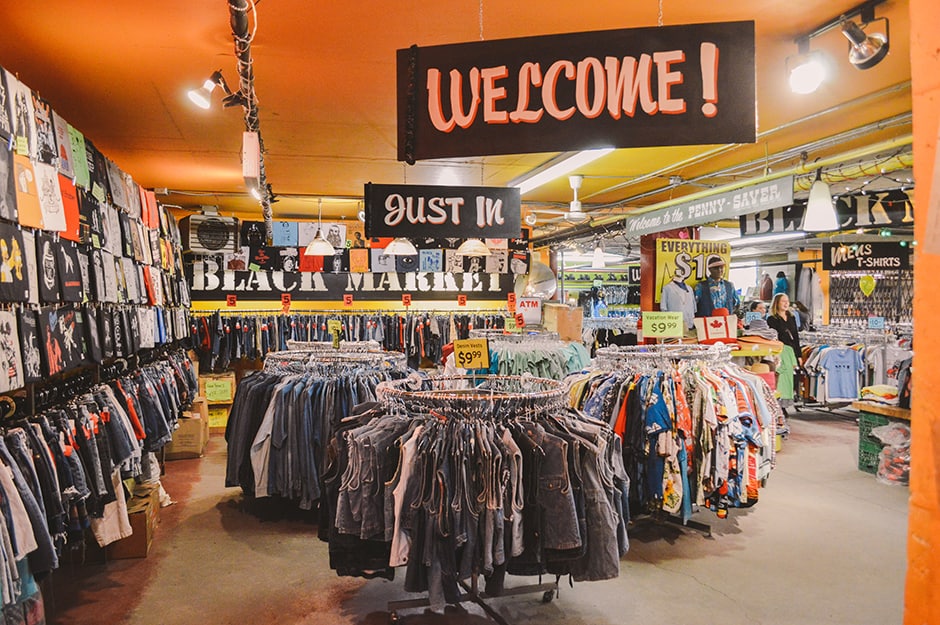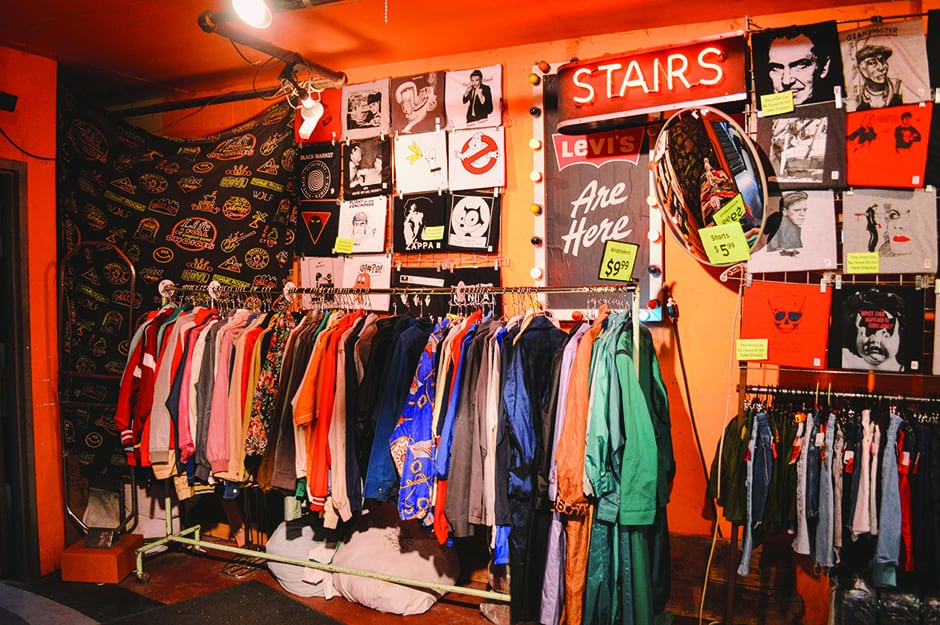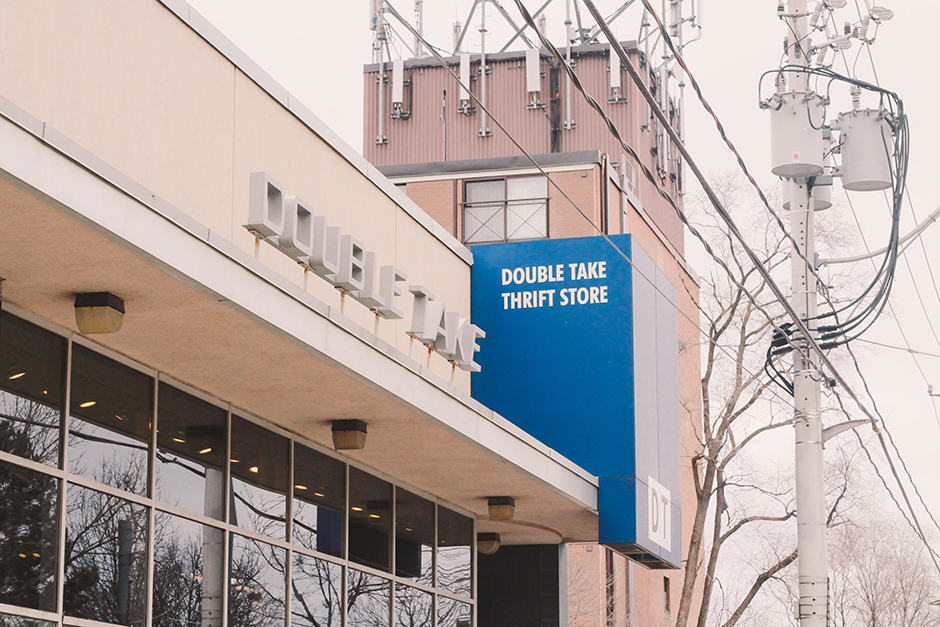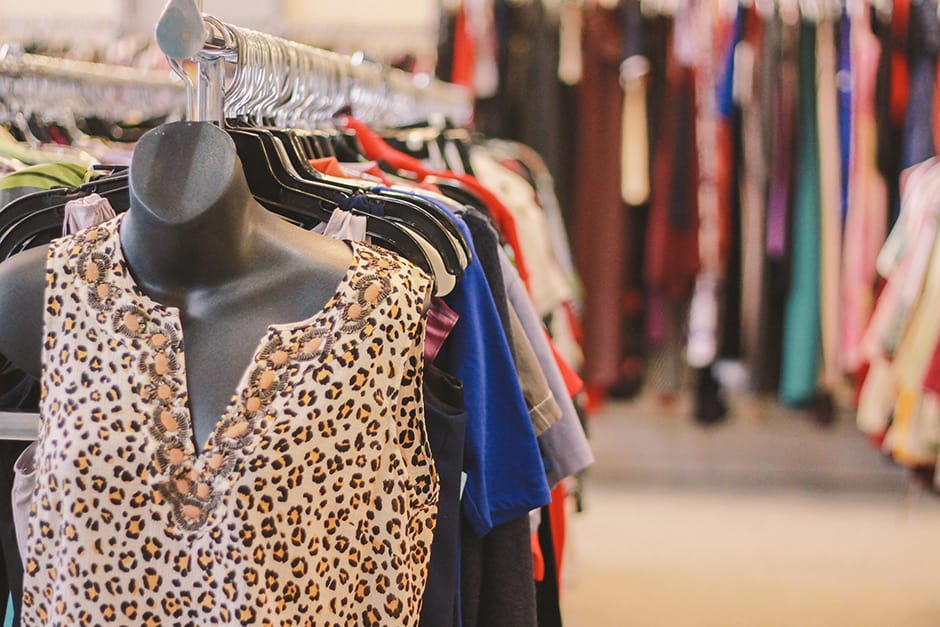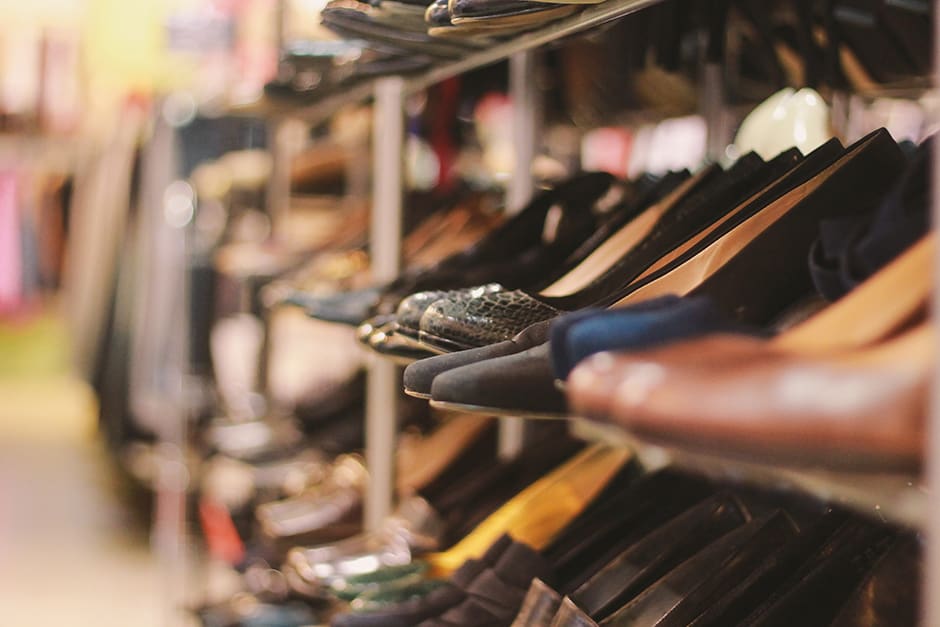I step inside Courage My Love, a vintage shop in the heart of Kensington Market, and am struck by an arresting medley of colour, pattern, and texture.
Vintage cowboy boots and artfully worn denim are arranged around the doorstep. Wooden beads and crystals hang from the ceiling. Bowls of vintage jewelry are perched on the countertops, and racks of men’s suits and flannel shirts line the walls.
Cece Scriver, owner, has a good mantra to sum up the store’s collection: “If you can’t find something somewhere, you can probably find it here.”
OLD TO NEW
This phrase rings true as I walk up and down the aisles of Courage My Love, which sells everything from belt buckles to antique lamps to pocket squares. The store is its own piece of art, taking objects and transforming them from used to vintage.
However, Scriver emphasizes that the store isn’t just about vintage. “We do seasonal stuff and we try to follow the trends,” she explains. “We get stuff that is in fashion or work with what we can get a lot of and turn it into fashion.”
The fusion between the old and the new becomes clear as I walk through the store. Rows of leather moccasins are tucked under shelves of silk scarves, while painted masks fill the gaps between the racks of clothing on the walls. Scriver points out a costume hat adorned with a sprig of cloth flowers, explaining that she sewed it herself.
The store’s mix of old and new pieces is emblematic of growing trends in the fashion industry. Trends have a tendency to lead a cyclical life, as marked by the return of high-waisted pants, grungy florals, and studded leather jackets.
However, unlike the efforts of the fashion world, which brings the old back in physically new pieces, the act of shopping vintage revives old items in a way that is amenable to high fashion and upcycling philosophies.
In 1980, Black Market Vintage opened on Queen Street West to provide a niche market catering to alternative clothing — one that, according to Tracey Opperman, didn’t really exist at the time. Opperman, along with John Christmann, the store founder, and Bernard Chung, are the co-owners of Black Market Vintage.
“I think there’s a segment of the population that will always want an alternative fashion to what is available in the standard retail environment,” Opperman explains. “…[We have] the ability to offer one-of-a-kind pieces that pre-date fast fashion.”
A stone’s throw from Osgoode subway station, the main Black Market store is actually located underground. After descending the narrow steps, I find myself in a vast, warehouse-style space. Racks of vintage band t-shirts, bomber jackets, and colourful sunglasses are everywhere. The atmosphere is reminiscent of the grungy, punk rock scene that dates back to the store’s inception. Best of all, everything is $10 or less.
Black Market also has a sister store in Parkdale. The Public Butter sells vintage clothing as well as furnishings, architectural salvage, used bicycles, and household goods.
The appeal of vintage fashion is twofold. Not only is it a unique way to make a statement, but many of the pieces sold in vintage shops are of exceptional quality, certainly compared to modern mass-produced goods. It’s up to shops like Black Market and Courage My Love to sift the treasure from the trash.
“A lot of vintage comes from an era of quality-made manufacturing that pre-dates fast-fashion,” Opperman emphasizes. “It just lasts longer, and [people are aware] that much of it would be landfill without the vintage and thrift stores of the world.”
A FAMILY JOURNEY
The stories behind some of Toronto’s thrift stores are in many ways as unique as the wares they sell. Often, they also serve to build neighbourhood communities.
Courage My Love started out as a “junk store,” opened by Scriver’s parents in 1975. Travelling across Toronto, and later all of Canada, they collected antiques and unique pieces to revitalize and sell at the store. They bought old stock from general stores when Scriver was only three or four years old. She referred to this as “dumpster diving, but not really,” explaining that you never know what valuable things people are going to toss to the curb.
Forty years later, the store has expanded its niche, but it remains a family business. The sense of engagement in the store’s management is clear. The majority of Scriver’s family lives in Kensington Market and is involved in the community. Employee turnover is low, resulting in a strong relationship between store workers as well as their customers.
As I spoke with Scriver, several customers that she knew by name drifted in and out of the store, exchanging friendly remarks. One customer dropped by to ask about how her family was doing. “That’s my uncle,” she explained.
“We’ve watched people who have grown up,” Scriver says. “…We do know how much this street has done for us and the community… We take care of what we have and know how much it means.”
SPLIT PERSPECTIVE
The language of thrifting tells a distinct story. “Vintage,” with its nod to eras past, implies unique and individual. It also doesn’t necessarily reflect low-cost. “Second-hand” or “used” can carry very different connotations. This language reflects a split in the existence of thrift stores which is very much reflective of the difference between the fashion-conscious “vintage” and the value-conscious “thrift.”
The impact of second-hand stores goes far beyond the physical goods you can purchase. They can also take the form of community-building efforts.
Double Take Thrift Store opened in 1999, and it quickly became a popular place in the neighbourhood to shop for inexpensive wares. The store is run through the Yonge Street Mission, an organization that provides services for the community, including food banks, daycare, and programs for street-involved youth.
“It was originally intended to help ease some of the difficulties people had financially and a way for donors to express giving,” says Kathy Webster, store manager. “It started as a one-room operation and became this store,” she adds.
COMMUNITY BUILDING
The main goal of the store and the Yonge Street Mission is to be an active partner in helping to eliminate poverty in Toronto.
Webster explains the multiple levels on which the store works to achieve this goal. “We are still here for the community which is still one of the most impoverished in Canada,” Webster says. She adds that the efforts go beyond the goods sold. “…Residents of the community [are] employed and trained and the mission supports them in building resumes, eventually helping them on their way to a career,” she says.
Located on Gerrard Street just east of Parliament Street, Double Take is right on the edge of Regent Park, Canada’s largest social housing project. Since 2005, the neighbourhood has been working through revitalization, aiming to curb poverty and youth crime and diminish the effects of its negative reputation.
Roaming the aisles of the store, the history and enduring reputation of the area is inconsequential. Clothing is well organized by size and shape, and a wide variety of books and knick-knacks are displayed in the corner. The store windows showcase neatly dressed mannequins modeling the latest fashions. The latter is of penultimate importance to Double Take, particularly their aim to create a shopping experience resembling that of a “regular” department store.
“We’re very much about respect,” Webster explains. “…Our aim is that no matter how much someone has to spend, whether it’s a dollar or a hundred dollars, they don’t feel belittled or like second-class citizens,” she adds.
It’s often a challenge, according to Webster, particularly in light of strict budget constraints. Regardless, Double Take operates on a relationship of mutual respect between customers and the retailer. Indicative of this is their dedication to ensuring every article of clothing is steam-cleaned. Additionally, many of the community members at the Yonge Street Mission receive gift certificates to shop at the store.
“We have a great number of loyal customers,” explains Webster. “We have a lot of personal, individual relationships — we know many of our customers by name,” she adds.
In light of the store’s humanitarian aims, this is particularly important. In order to tackle multifaceted and complex problems like poverty and street involvement, Webster says, the Yonge Street Mission and Double Take seek to create a “ripple effect,” helping individuals who will themselves go on to change the community for the better.
“We don’t offer a hand out, we offer a hand up,” Webster adds. Creating agency for individuals is a core component of that mentality, Webster explains, saying, “We work together with people, rather than simply directing them.”
BEYOND THE RACK
Over time, Toronto has evolved as a vibrant hub for culture and ideas. Thrift and vintage shopping is just another piece of the puzzle.
Some of this impact comes from the stores themselves. Scriver and her family have played a crucial part in shaping the Kensington Market neighbourhood into what it is today.
“What I’ve been told is that in the ’80s when we moved to Kensington Market… we were the first in the area and we shifted the whole market into what it is now,” Scriver explains, “where more fashionable people are coming in.”
Since Courage My Love opened, Kensington has become one of the prime spots in Toronto for vintage wares. Numerous stores have opened up in the neighbourhood, making it a shopping hotspot for tourists and locals alike.
“Toronto has a big vintage scene,” says Scriver. “People come from other countries to shop here for their stores,” she adds.
There is a growing presence of thrift stores in Toronto that cater to different demographics and needs.
“Toronto can be a very expensive city, especially for youth and students,” Opperman says. “[Black Market offers] an affordable option that’s unique and funky.”
Thrift and vintage has been steadily growing in popularity, with students increasingly becoming a core demographic. “Our love of pop culture has a direct correlation to how we pick and purchase merchandise for the store, so it speaks to many generations,” Opperman says. “We love to see what the students are wearing and hear what they’re looking for,” she adds.
The University of Toronto is not new to the thrift and vintage scene; in fact, many groups on campus have set up related events. For example, clothing swaps hosted by organizations like Caffiends and UFashion allow students to bring in their gently used items to trade with others.
Entrenching thrifting habits into younger generations could have a significant positive impact on larger social movements. Vintage shopping has been connected to environmentalism in an attempt to promote recycling and reduce waste.
“Many people say this generation, [they] only think about themselves, and I don’t believe that at all,” Webster emphasizes. “I see many young people with a high social conscience.”
Characteristic of many thrift stores is the sense of finding value in something that others cast away. Depending on the stores’ aims, this awareness can be manifested in their respect and understanding of generations past or their goals to build a sense of community. Making the choice to buy used is a support of these efforts, which, in many ways, extends beyond the desire for the material thing.
“I think there should be more thrift shops and more emphasis on this activity, and less emphasis on buying the newest, greatest thing,” Webster says. “There’s nothing wrong with buying new things, but perhaps less consumerism could be achieved through things like thrift stores.”
With pasts as diverse as the objects they display, Toronto thrift stores and the growing culture surrounding them bring something unique to the retail world. They bring new life to old possessions and an awareness of the value of saving rather than throwing away, creating a sense that the purchase you carry out the door is not something bought, but something borrowed.

